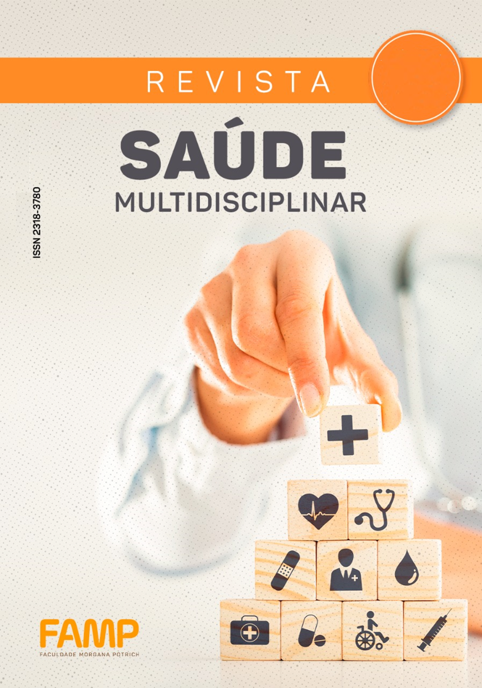Physical therapy strategies on the functionality of a patient diagnosed with Stroke: a case study
DOI:
https://doi.org/10.53740/rsm.v16i1.756Keywords:
Stroke, Functional Capacity, Physical TherapyAbstract
Introduction: Cerebrovascular accident (CVA) involves the interruption of blood flow in the brain, resulting in permanent neurological damage. Risk factors include stress, older age, high cholesterol, hypertension, smoking, alcohol, diabetes, heart disease, physical inactivity, and obesity. Stroke can be ischemic (interruption of blood flow), hemorrhagic (rupture of vessels), or transient (temporary lack of flow). Ischemic stroke has several phases: hyperacute (0-24 hours), acute (1-7 days), early subacute (7 days to 3 months), late (3-6 months) and chronic (more than 6 months). Regardless of the type or stage, stroke causes sudden symptoms of loss of function, which can be severe and even fatal. Objective: To describe the physical therapy strategies used in the rehabilitation of a patient diagnosed with ischemic stroke and to verify the effects on functionality. Case report: This is a case study consisting of a comprehensive initial assessment of the patient's physical and functional status. Based on the results of this evaluation, specific therapeutic goals and procedures to be followed during the study period were established. The intervention was designed and conducted according to the identified needs, namely: stretching and muscle strengthening, balance training, gait training, weight unloading, stimuli to regain sensitivity, among others. Treatment sessions were conducted twice a week, at the FAMP School of Physiotherapy Clinic. After intervention, the patient showed improvement in balance, muscle strength and tone, and improved gait (no longer necessary for assistance) and obtained the maximum score in the Functional Independence Measure, the main outcome of the study. Through these results, the importance of the role of physical therapy for the rehabilitation of post-stroke patients is highlighted, especially regarding its functionality.
References
Gonçalves JL, Feitosa ES, Borges RT. Perfil epidemiológico de vítimas de acidente vascular encefálico em um hospital de referência do Ceará/Brasil. Revista Interdisciplinar. 2019;12(2):92-103.
Ferreira MP, Zotz TG, Mélo TR, Israel VL. Relatos de Séries de Casos de Adultos Institucionalizados com Deficiência Múltipla: Como Avaliar a Funcionalidade?. Rev bras educ espec [Internet]. 2019;25(1):55–66. Available from: https://doi.org/10.1590/S1413-65382519000100004
Silva ES,; Borges JWP, Moreira TMM, Rodrigues MTP, Souza ACC. Prevalência e fatores de risco associados ao acidente vascular cerebral em pessoas com hipertensão arterial: uma análise hierarquizada. Rev. Enf. Ref. [Internet]. 2020 Jul [citado 2023 Out 25] ; serV(3):e20014-e20014. Disponível em: http://scielo.pt/scielo.php?script=sci_arttext&pid=S0874-02832020000300009&lng=pt.
Ferretti C. Alterações fisiológicas, doenças e manifestações clínicas em geriatria. São Paulo: Editora Senac; 2019.
Ferreira Neto F, Nascimento JS, Jesus ACC, Barauna L, Ribeiro NMS. Efeitos do treinamento muscular respiratório em pacientes após acidente vascular cerebral: uma revisão sistemática. Rev Pesqui Fisioter. 2020;10(4):754-763.
Organização Mundial da Saúde. Global health estimates: Leading causes of death. Genebra: OMS; 2019. Disponível em: https://www.who.int/ data/gho/data/themes/mortality-and-global-health-estimates/ghe-leading-causes-of-death Acesso em: 01/09/2023.
Araújo JP, Darcis JVV, Tomas ACV, Mello WA. Mortality Trend Due to Cerebrovascular Accident in the City of Maringá, Paraná between the Years of 2005 to 2015. Int J Cardiovasc Sci [Internet]. 2018Jan;31(1):56–62. Available from: https://doi.org/10.5935/2359-4802.20170097
Moita SM, Cardoso AN, Guimarães IP, Rodrigues KS, Gomes MLF, Amaral VF et al. Reconhecimento dos sinais e sintomas e dos fatores de risco do acidente vascular cerebral por leigos: uma revisão integrativa. Research, Society and Development. 2021;10(10):e587101019340.
Antonio DH, Bravo GRM, Sigolo JR, Palma R, Prestes SCC, Coelho TR de F. Perfil funcional de pacientes com AVC isquêmico trombolizados e não trombolizados classificados pela CIF/ Functional profile of thrombolyzed and nonthrombolyzed ischemic stroke patients classified by the CIF. Braz. J. Develop. [Internet]. 2021 Jul. 16 [cited 2023 Oct. 25];7(7):72074-83. Available from: https://ojs.brazilianjournals.com.br/ojs/index.php/BRJD/article/view/33091.
Camargo AFB. Efeito adjuvante de reabilitação utilizando realidade virtual em pacientes pós acidente vascular cerebral isquêmico. 2019 (98 p.). Dissertação (mestrado) - Universidade Estadual de Campinas, Faculdade de Ciências Médicas, Campinas, SP. Disponível em: https://hdl.handle.net/20.500.12733/1637461. Acesso em: 24 out. 2023.
Santos MF, Teixeira HP, Coelho LP. Neuropsicologia e reabilitação cognitiva em pacientes acometidos de Acidente Vascular Encefálico. Revista Transformar. 2018;12(1):1-25.
Sofiatti S de L, Oliveira MM de, Gomes LM, Vieira KVS. A importância da fisioterapia na capacidade funcional de idosos com risco de quedas. RBMC [Internet]. 15º de abril de 2021 [citado 24º de outubro de 2023];7(17). Disponível em: https://rbmc.emnuvens.com.br/rbmc/article/view/87
Freitas AO, Amorim PB, Santos RS. A fisioterapia nos pacientes com sequelas decorrentes de Acidente Vascular Cerebral – AVE, atendidos pela “ESF Vila Nova” da cidade de Pinheiros/ES. RECIMA21 [Internet]. 31º de outubro de 2021 [citado 25º de outubro de 2023];2(10):e210790. Disponível em: https://recima21.com.br/index.php/recima21/article/view/790.
Pereira MG. Epidemiologia: teoria e prática. Rio de Janeiro: Guanabara Koogan; 2003.
Kendall FP, McCreary EK, Provance PG, Rodgers MM, Romani WA, Kendall HO. Músculos: provas e funções. 5. ed. Barueri: Manole; 2007.
Ansari NN, Naghdi S, Mashayekhi M, Hasson S, Fakhari Z, Jalaie S. Intra-rater reliability of the Modified Modified Ashworth Scale (MMAS) in the assessment of upper-limb muscle spasticity. NeuroRehabilitation. 2012;31(2):215-222.
Brandt T, Strupp M. General vestibular testing. Clin Neurophysiol. 2005;116(2):406-426.
Riberto M, Miyazaki MH, Jucá SSH, Sakamoto H, Pinto PPN, Battistella LR. Validação da Versão Brasileira da Medida de Independência Funcional. Acta Fisiátr. [Internet]. 9 de agosto de 2004 [citado 24 de outubro de 2023];11(2):72-6. Disponível em: https://www.revistas.usp.br/actafisiatrica/article/view/102481
Martins ER, Silva LGB, Osório LMO, Souza RCJ, Costa ES, Santana GM, Farias RRS. Abordagem fisioterapêutica em pacientes com Acidente Vascular Encefálico (AVE). Casoseconsultoria [Internet]. 9º de outubro de 2022 [citado 24º de outubro de 2023];13(1):e29139. Disponível em: https://periodicos.ufrn.br/casoseconsultoria/article/view/29139.
Rodrigues GC, Mazzola D. Fisioterapia em grupo na reabilitação de indivíduos pós acidente vascular encefálico (AVE). Vivências. 2019;15(28):245-254.
Alashram AR, Annino G, Aldajah S, Raju M, Padua E. Rehabilitation of limb apraxia in patients following stroke: a systematic review. Appl Neuropsychol Adult. 2021:1–11. doi: 10.1080/23279095.2021.1900188
Gomes AC, Santos CT, Sousa GC, Queiroz SS, Ribeiro MF. Atuação da fisioterapia no tratamento de pacientes com Acidente Vascular Encefálico (AVE). SciGen [Internet]. 5º de janeiro de 2022 [citado 24º de outubro de 2023];2(Supl.1):64-. Disponível em: http://www.scientiageneralis.com.br/index.php/SG/article/view/306
Santos MDL, Barcyscyn JT, Amarantes WA. A aplicação da fisioterapia na reabilitação pós Acidente Vascular Encefálico. Renovare. 2019;3(6):5-22.
Sampaio IC, Machado T. O acesso de indivíduos após-acidente vascular encefálico aos serviços de fisioterapia: revisão integrativa da literatura. Rev. Pesqui. Fisioter. 2020;10(3):566-576.
Silva TIC, Silva GO, Santos KF, Gondin LCS, Araújo NF. Benefícios da fisioterapia no tratamento de um paciente com AVC. São Paulo: SBPCNET; 2014.
Lima JB, Conceição NMP, Tapparelli YA. A fisioterapia motora no processo de reabilitação do acidente Vascular Encefálico. SAÚDE [Internet]. 16º de fevereiro de 2022 [citado 24º de outubro de 2023];15(23):87-95. Disponível em: https://revistasuninter.com/revistasaude/index.php/saudeDesenvolvimento/article/view/1258
Billinger SA, Arena R, Bernhardt J, Eng JJ, Franklin BA, Johnson CM et al. Physical activity and exercise recommendations for stroke survivors: a statement for healthcare professionals from the American Heart Association/American Stroke Association. Stroke. 2014;45(8):2532-53.
Martins ER, Silva LGB, Osório LMO, Souza RCJ, Costa ES, Santana GM et al. Abordagem fisioterapêutica em pacientes com Acidente Vascular Encefálico (AVE). Casoseconsultoria [Internet]. 9º de outubro de 2022 [citado 24º de outubro de 2023];13(1):e29139. Disponível em: https://periodicos.ufrn.br/casoseconsultoria/article/view/29139
Additional Files
Published
How to Cite
Issue
Section
License
Copyright (c) 2024 REVISTA SAÚDE MULTIDISCIPLINAR

This work is licensed under a Creative Commons Attribution-NonCommercial-NoDerivatives 4.0 International License.









